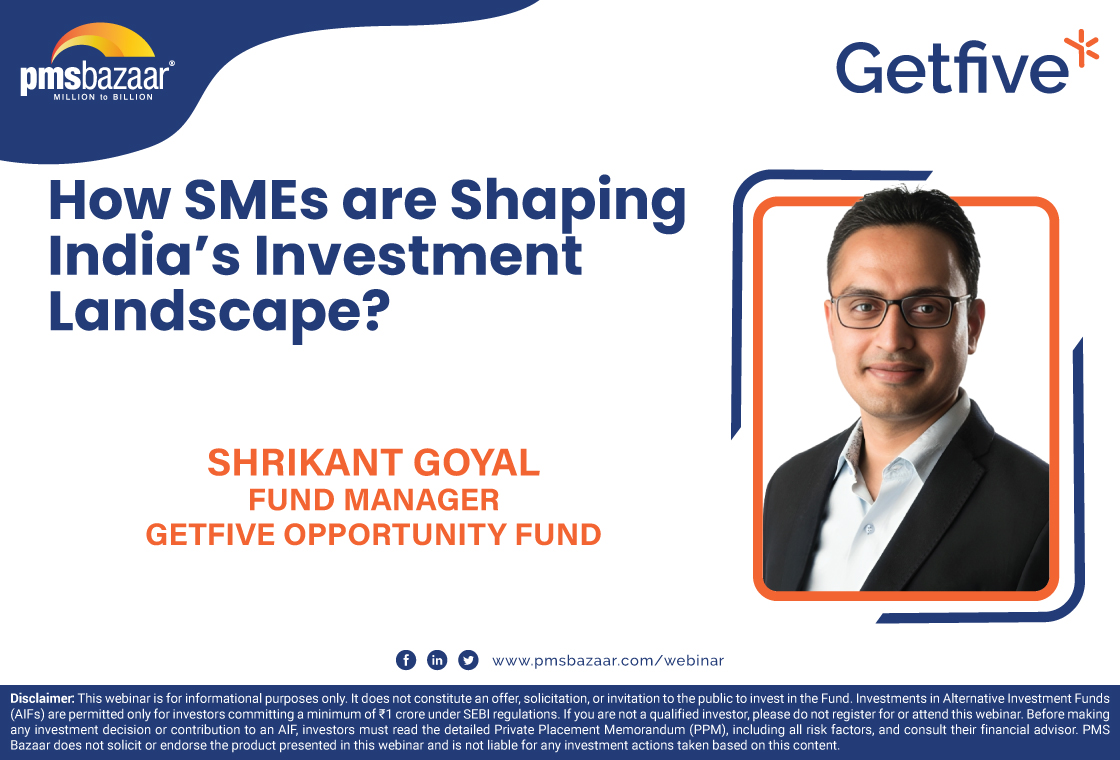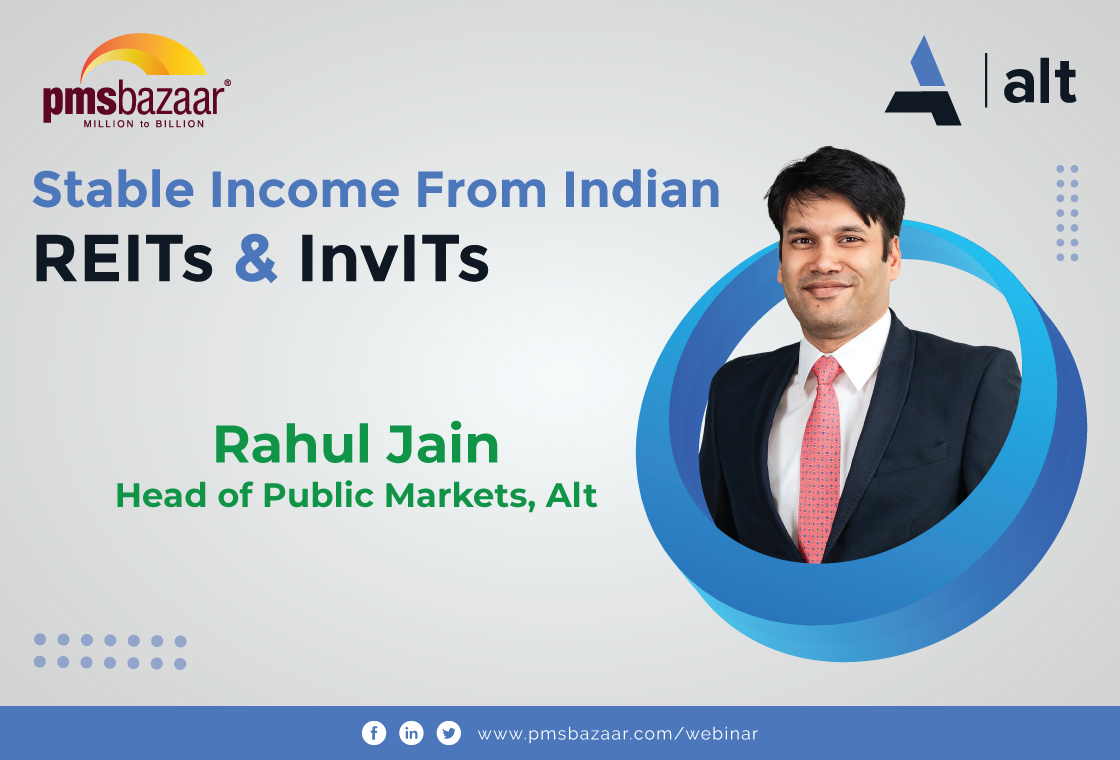PMS Bazaar held a webinar titled "Where to Invest Now? Navigating Indian Equities After Elections." The session featured Arun Subrahmanyam, Founder and Managing Partner of Ampersand Capital.

This webinar unpacked navigating the market post the election outcome. It highlighted Modi 3.0's potential for stability and emphasised key investment factors such as management quality and market potential. Sector expectations, portfolio construction, and managing volatility through diversification and investment cycles were also covered.
Key aspects covered in the blog are
- Government stability and market outlook
- Ampersand’s portfolio construction
- Sectoral expectations
- Portfolio reshuffling
Government stability and market outlook
Subrahmanyam began with the election outcome. He acknowledged that many experts had already analysed it in detail. A stable government, which fosters continuity, is what truly drives market confidence and growth, according to him.
Subrahmanyam expects Modi's third term to prioritise job creation and the rural economy. He also anticipates continued emphasis on infrastructure development. Additionally, the expectation of lower interest rates is likely to further enhance the effects of economic reforms. The recent market rallies, Subrahmanyam argues, highlighted the importance of the current government's stability and continuity for the stock markets.
Macroeconomic factors will be crucial in determining the market's direction, according to Subrahmanyam. He pointed out that high interest rates have been a hurdle, but their easing will unlock the full potential of the economic reforms. Favourable rainfall and a global easing of monetary policies, as signalled by the US Federal Reserve, are also expected to have a positive impact on India's economic growth.
He then outlined the key criteria for his investments. Management quality is the top priority, and companies must meet their fund's high standards. The business must also have a large potential market and a competitive advantage to expand its market share and scale up significantly. Lastly, Ampersand aims to invest at the bottom of the business cycle and sell at the top, although this timing isn't always perfect. However, decades of experience give the team confidence in their ability to closely monitor these cycles.
Ampersand’s portfolio construction
Subrahmanyam emphasised that growth is the key driver of stock prices. While valuations are important, expensive stocks offer limited room for valuation gains. Therefore, their fund focuses on companies with reasonable valuations that are positioned for strong growth.
He identified three key themes: energy transition, premiumisation, and technology and research. These themes have been in focus for over a year and are expected to be major growth drivers going forward.
The energy sector in India is undergoing a significant transformation with increased investments. Subrahmanyam believes ancillary or power equipment companies are the best way to play this theme. These companies are expected to generate substantial alpha due to their long-term growth visibility and earnings growth potential of 20-25% over the next 3-5 years.
Premiumisation is a theme that cuts across multiple sectors, offering superior growth and high returns on capital employed (ROCs). This trend is evident in sectors like hotels, energy drinks, and fashion retail. Companies like Varun Beverages (which transitioned from a franchisee to an energy drink player) exemplify the growth potential within this theme. Similarly, fashion retailers like Trent and auto companies like Mahindra and Mahindra showcase the success of premiumisation.
While India lacks pure-play AI companies, there are opportunities in contract research and pharma companies. These companies benefit from India's large pool of scientists and supply drugs to innovators globally.
The power sector has been a dominant driver of India's capex scheme. The sector's strong performance over the past few years has been a key focus of the scheme's strategy. The consistent investment in power reflects the sector's growth potential and its role in the country's infrastructure development.
Sectoral expectations
Subrahmanyam offered his perspective on the recent market performance and future outlook. Despite uncertainties, the market has shown resilience and recovered from losses. He emphasized the importance of continuity and selective investment for stability. Foreign investors played a role, but domestic investors drove the recent rally. Subrahmanyam expects FIIs to return when global interest rates change. He anticipates potential corrections, particularly around budgets, but these could present buying opportunities.
Subrahmanyam discussed sectors likely to perform well. FMCG and IT have gained momentum, but the focus is on discretionary spending and structural growth themes like capital goods and industrials. He stated that he preferred discretionary spending, which benefits from lower interest rates, and structural growth themes. The IT sector's performance is linked to global factors, so the fund takes a cautious approach.
Similarly, he sees opportunities in construction and a gradual reallocation of resources, but this doesn't signify a preference for consumption over manufacturing. He emphasised a balanced approach and a diversified portfolio across various sectors.
Subrahmanyam acknowledged the defence sector's strong performance but advised caution due to high valuations. He sees it as a multi-year theme but suggests investors be selective and consider holding existing positions rather than seeking new entries.
Portfolio reshuffling
On market volatility, Subrahmanyam advised against frequent portfolio reshuffling due to tax implications and short-term market changes. He recommends minor adjustments based on sector underweights. He emphasises that significant reshuffling is unnecessary if the investment thesis remains unchanged.
Subrahmanyam explained their long-only investment approach with a minimum three-year horizon. This allows navigating volatility and uncertainties, aiming for long-term growth rather than short-term gains.
Subrahmanyam covered all the topics mentioned above in-depth and answered questions from the audience toward the end of the session. For more detailed view watch the recording through the appended link below.
Get access to rich data and analytics of PMS & AIF by subscribing to us. Join the 65000+ investors & experts: Subscribe NOW
Recent Blogs
.jpg)
Passively Active Investing — A Modern Investor’s Lens on ETF-Based PMS
PMS Bazaar recently organized a webinar titled “Passively Active Investing — A Modern Investor’s Lens on ETF-Based PMS,” which featured Mr. Karan Bhatia, Co-Founder and Co-Fund Manager , Pricebridge Honeycomb ETF PMs. This blog covers the important points shared in this insightful webinar.

Spot the Trouble: Red Flags in Equity Investment Analysis
PMS Bazaar recently organized a webinar titled “Spot the Trouble: Red Flags in Equity Investment Analysis,” which featured Mr. Arpit Shah, Co-Founder & Director, Care Portfolio Managers. This blog covers the important points shared in this insightful webinar.

Long-Only AIFs Rebound Sharply in October; Long-Short Strategies Lag Despite Lower Volatility
106 long-only AIFs averaged 3.68% vs 32 long-short AIFs at 2.7%; only 24–31% of funds beat key indices

Markets log strongest monthly gains in 7 months; PMS performance turns near-uniform in October
Nifty 50 TRI gained 4.62%, BSE 500 TRI rose 4.27%; 415 of 427 equity PMSes ended positive

How SMEs are Shaping India’s Investment Landscape?
PMS Bazaar recently organized a webinar titled “How SMEs are Shaping India’s Investment Landscape?” which featured Mr. Shrikant Goyal, Fund Manager, GetFive Opportunity Fund.

Stable Income from Indian REITs and InvITs
PMS Bazaar recently organized a webinar titled “Stable Income from Indian REITs and InvITs,” which featured Mr. Rahul Jain, Head of Public Markets, Alt.

5 Key Considerations Before Investing in AIFs in India
Alternative Investment Funds (AIFs) have emerged as a compelling option for sophisticated investors seeking diversification and potentially superior returns. But venturing into AIFs requires a clear understanding of their unique characteristics that go beyond simply knowing what they are and their categories.

How AIF can help in diversification?
Traditionally, Indian investors have relied on a mix of stocks and bonds to build their wealth. While this approach offers diversification, it can still leave your portfolio vulnerable to market fluctuations. Enter Alternative Investment Funds (AIFs), a dynamic asset class gaining traction for its ability to unlock diversification beyond the realm of conventional options.

